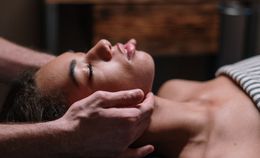According to the National Health Interview Survey, back pain is the leading reason people use, what they call, 'complementary and alternative medicine' (CAM). If you suffer from ongoing back pain or if you looking for an alternative treatment for low back pain, we've got some great information for you! In this article, we review the top 11 holistic treatments for back pain relief. These include:
The National Center for Complementary and Integrative Health (NCCIH) has funded many studies on the effectiveness of CAM for the treatment of back pain, chronic back pain, low back pain, neck pain. Most studies have found that the "benefit of CAM treatments was mostly evident immediately or shortly after the end of the treatment and then faded with time."
This suggests that for many treatments, you may need ongoing treatment in order to maintain the benefits associated with the therapy. In addition, many of the year-long studies funded by the NCCIH suggest that the long term benefits are associated with the frequency and can be maintained after a year (usually of weekly treatment). In other words, don't expect a miracle in one or two treatments.
Complementary and Alternative Treatments for Back Pain
Here are the treatment modalities that have been found to be helpful in treating back pain:
There is scientific evidence supporting the use of acupuncture in the treatment of chronic low back, neck pain, osteoarthritis, and chronic headache. Millions of Americans use acupuncture each year, and the treatment is safe when performed by a trained professional. One of the most common side-effects is bleeding.
Read more about acupuncture for back pain.
Scientific evidence demonstrates that massage therapy is beneficial for the treatment of ongoing back pain. The bad news is, the relief is often short-lasting and requires ongoing treatment to maintain the positive benefits.
A 2008 research review and 2011 NCCIH-funded clinical trial concluded that massage may be useful for chronic low-back pain.
Massage therapy has also been shown to help with chronic neck pain. In a 2009 study, patients received weekly massage. After 10 weeks, those receiving massage reported fewer symptoms of pain and after 26 weeks reported improved neck function.
Studies have also shown that massage may also help with pain from osteoarthritis. Other studies show positive effects for pregnancy and labor pain as well.
Read more about massage for back pain.
Spinal manipulation may be performed by chiropractors, osteopathic physicians, and physical therapists and has been found to improve function as well as reduce pain. Studies have shown chiropractic manipulation to be effective for the treatment of chronic (lasting more than three months) and acute (triggered by disease of injury) pain.
While Chiropractic manipulation has been shown to reduce the intensity of low-back pain, keep in mind that the most common side effects are tiredness and muscle soreness after adjustment. There are also risks associated with the manipulation of the cervical spine, and while the chance of worsening herniated disks is low, it is still present.
Read more about chiropractic for back pain.
Similar to chiropractic manipulation, osteopathic manipulative treatment (OMT) is a holistic treatment used by osteopathic physicians to help patients with back pain. The impressive thing about OMT is that studies have shown that the beneficial effects last for several months after treatment.
Craniosacral therapy may be used in conjunction with other therapies, such as massage therapy, chiropractic, or osteopathic manipulative treatment. Studies have demonstrated craniosacral therapy as an effective treatment for pain, reducing functional disability and improving physical quality of life. Studies have also shown that it reduces pressure pain sensitivity and improves body awareness after 8 weeks of treatment.
A year-long study funded by the NCCIH found that a "structured yoga program may be an alternative to physical therapy for people with chronic low-back pain." One of the major outcomes of the study was the reduction in pain medication use. After just 12 weeks, the participants doing physical therapy and Yoga were less likely to use pain medication. In addition, the positive results lasted after the year-long study and seemed to be linked to the number of sessions attended. If you suffer from chronic back pain, better start a regimen of daily Yoga.
Similar to Yoga, physical therapy, and other forms of exercise, the practice of Tai Chi and Qi Gong has various health benefits, which may include a temporary reduction in the experience of pain, including back pain.
The practice of meditation, guided visualization, and progressive relaxation have some supporting evidence in helping to reduce the experience of chronic pain, particularly musculoskeletal pain (pain associated with muscles and bones). However, more research is necessary to determine its overall effectiveness in the relief of back pain. Since the cost and difficulty of learning to meditate is low and the side effect minimal, there's really no reason not to give meditation or other types of relaxation techniques a try for your back pain.
Read more about Meditation for back pain.
Other Therapies
Scientific evidence shows that other therapies, such as cognitive-behavioral therapy, exercise, physical medicine and rehabilitation, and interdisciplinary rehabilitation are also beneficial for treating chronic back pain and subacute back pain (lasting less than four weeks).
Supplements and Natural Remedies
Most supplements that help with back pain are associated with reducing inflammation.
Glucosamine and Chondroitin
While Glucosamine and Chondroitin may be effective for joint health, their use as a supplement to support back pain is inconclusive. Although several studies have been performed, the evidence is scant as to their effectiveness.
Vitamin D
There are many studies linking Vitamin D deficiency to chronic pain, and therefore, boosting your Vitamin D levels may help to alleviate chronic pain if you are deficient. If you are interested in a high-dose Vitamin D prescription, talk with your doctor.
Comfrey Root Extract Ointment
Research done on Comfrey root extract has demonstrated its ability to reduce acute back pain.
Other Treatments for back pain
Tiger Balm and other such ointments can often temporarily relieve acute back pain. The ingredients in Tiger's Balm include:
- Camphor
- Menthol
- Cajuput Oil
- Dementholised Mint Oil
- Clove Oil
- Clove Oil
Ginger is also a natural herb that can be used in cooking and contains anti-inflammatory properties that can be beneficial in the reduction of pain. There are many other foods that have anti-inflammatory properties that you may want to consider.
Hot and cold packs are also a natural remedy for back pain that may help with temporary relief.
References
Atkins, DV, and DA Eichler. "The Effects of Self-Massage on Osteoarthritis of the Knee: a Randomized, Controlled Trial". Int J Ther Massage Bodywork, vol. 6, 2013, pp. 4-14., www.ncbi.nlm.nih.gov/pubmed/23482239. Accessed 24 June 2018.
Chou R, Qaseem A, Snow V, Casey D, Cross JT, Shekelle P, et al. Diagnosis and Treatment of Low Back Pain: A Joint Clinical Practice Guideline from the American College of Physicians and the American Pain Society. Ann Intern Med. 2007;147:478-491. Retrieved June 24, 2018 from https://www.acpjournals.org/doi/10.7326/0003-4819-147-7-200710020-00006.
Complementary and Alternative Therapies for Back Pain. Content last reviewed October 2014. Agency for Healthcare Research and Quality, Rockville, MD. Retrieved June 24, 2018 from http://archive.ahrq.gov/research/findings/evidence-based-reports/backcam2tp.html.
Field, T. (2010). Pregnancy and labor massage. Expert Review of Obstetrics & Gynecology, 5(2), 177-181. http://doi.org/10.1586/eog.10.12. Retrieved June 24, 2018 from https://www.ncbi.nlm.nih.gov/pmc/articles/PMC2870995/.
Giannetti BM, Staiger C, Bulitta M, et al Efficacy and safety of comfrey root extract ointment in the treatment of acute upper or lower back pain: results of a double-blind, randomised, placebo controlled, multicentre trial British Journal of Sports Medicine 2010;44:637-641.Retrieved June 24, 2018, from http://bjsm.bmj.com/content/44/9/637.
Hall, A., Maher, C., Lam, P., Ferreira, M., & Latimer, J. (2011). Tai Chi exercise for treatment of pain and disability in people with persistent low back pain: A randomized controlled trial. Arthritis Care Res (Hoboken),63(11), 1576-83. Retrieved June 24, 2018, from https://www.ncbi.nlm.nih.gov/pubmed/22034119.
National Center for Health Statistics. (2018, March 12). Retrieved June 24, 2018, from https://www.cdc.gov/nchs/nhis/data-questionnaires-documentation.htm
Saper RB, Lemaster C, Delitto A, et al. Yoga, physical therapy, or education for chronic low back pain: a randomized controlled noninferiority trial. Annals of Internal Medicine. June 19, 2017. Retrieved June 24, 2018 from https://www.ncbi.nlm.nih.gov/pubmed/28631003.
Sherman KJ, Cherkin DC, Hawkes RJ, et al. Randomized trial of therapeutic massage for chronic neck pain. Clinical Journal of Pain. 2009;25(3):233-238. Retrieved June 24, 2018 from https://www.ncbi.nlm.nih.gov/pubmed/19333174.
Sodha R, Sivanadarajah N, Alam M. The use of glucosamine for chronic low back pain: a systematic review of randomised control trials. BMJ Open 2013;3:e001167. doi: 10.1136/bmjopen-2012-001167. Retrieved June 24, 2018 from http://bmjopen.bmj.com/content/3/6/e001167.
Straube, S., Derry, S., Moore, R. A., & McQuay, H. J. (2010). Vitamin D for the treatment of chronic painful conditions in adults. The Cochrane Database of Systematic Reviews, (1), CD007771. Retrieved June 24, 2018 from https://www.ncbi.nlm.nih.gov/pmc/articles/PMC4170888/.
Vickers, A., Cronin, A., & Maschino, A. (2012). Acupuncture for chronic pain: Individual patient data meta-analysis. Arch Intern Med.,172(19), 1444-53. Retrieved June 24, 2018, from https://www.ncbi.nlm.nih.gov/pubmed/22965186.
Zeldan, F., Martucci, K., Kraft, R., Gordon, N., McHaffie, J., & Coghill, R. (2011). Brain mechanisms supporting the modulation of pain by mindfulness meditation. J Neurosci, 31(14), 5540-48. Retrieved June 24, 2018, from https://www.ncbi.nlm.nih.gov/pubmed/21471390.





















